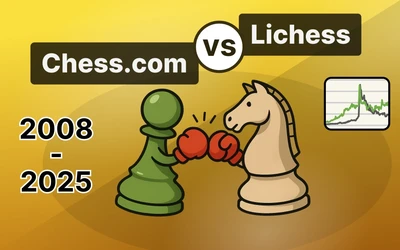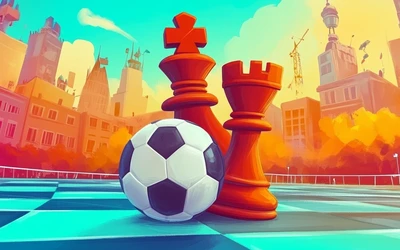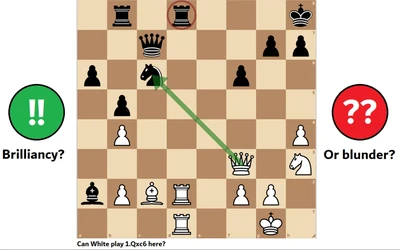
Reverse Your Move Order! The same idea might just win
How often do you check for move order improvements?Great chess players often say “When you find a good tactic, look for a better one.”
What if the better one is hiding inside the same idea, just in a different move order? This happens more often than you think! Psychologically it’s easy to become over-attached to the first tactical idea you find that looks playable. But how should it actually be carried out? Tactics often contain multiple moves, so they can be refined and executed in different sequences. Reversing the move order is one of the simplest ways to potentially sharpen a combination, yet it’s a habit many players overlook.
This article also works as a follow-up to my earlier lesson "Don’t Forget the Backward Moves!" Do also check out that one, as both articles focus on calculation habits that often get neglected. Whether it’s spotting backward moves or rethinking your move order, these are subtle but powerful concepts worth keeping in mind.
This article is a painful tour through my own missed opportunities. I’ve gathered five examples where I found the tactical motif, played the key moves but executed the idea in the wrong sequence. And it has been costly! I scored 2 out of 5 in these games, but I really should have gotten 5/5 if I played the move order correctly. When we miss tactics completely, it’s often because we didn’t recognize the underlying motif, and that is part of learning. But when we spotted the right idea and still misplay it, it’s a fixable habit. It might just mean reordering what we already saw.
For each position I will first give the actual (suboptimal) game continuation I played. Your task is to find the stronger version of the tactic and train the habit of revisiting each tactical shot with move order in mind. Hopefully these examples show just how important the move sequence can be.
In the first position Black had just taken a pawn on c2. What is the best continuation?
Position 1A: White to play (Actual game)
Position 1B: White to play (Try to improve on above - Find the best move)
In this game I immediately retook with 1.Qxc2 thinking I would pick up 2 pawns on g4 and b4 with 2.Rxg4+, and grind out a win with my passed a-pawn. The game is not over, but I was content with the resulting position. However, as position 1B shows, reversing the order of the 2-move sequence by first playing 1.Rg4+ simply wins immediately. This kind of oversight is a blind spot of not checking for move orders. We must learn to check for move orders as independent moves within the same idea!
In the second position playing as black I spot something in the position based on loose pieces:
Position 2A: Black to play (Actual game)
Position 2B: Black to play (Find the best move)
Looking at the game variation again compared to the best move, it is actually quite comical. I had the tactical motif right with the Qa5 fork, but there was no reason to sacrifice the exchange on e1 first! If I reversed the move order (Qa5 first followed by Rxe1 instead of Rxe1 followed by Qa5) I would have won a clean piece rather than getting 2 pieces for a rook. I think this is due to Rxe1 seeming more forcing, therefore it was the variation first I spotted and I was too satisfied with the variation to check for move orders. Again this shows once we see something tactical, our brain clings to it like it’s the only version that exists.
In the next position I can win the c7 pawn. How should White go about it?
Position 3A: White to play (Actual game)
Position 3B: White to play (Find the best move)
Because I played the “natural” Qh7+ first (before Rxc7), this time I missed the win entirely. This was one of those positions where the moves of the sequence seems so automatic that we won’t even consider anything else. By reversing it, playing Rxc7 first as a decoy, is quite unexpected but wins decisively. Perhaps I will do deep dive on this kind of pattern in an later article? But for now, just spending a minute to check the move order of my plan would have resulted in an immediate win.
The final two examples are more difficult and require deeper calculation. But if you’ve already gotten into the habit of checking move orders on your tactics, I’m confident you’ll spot the correct ideas here too.
Black has a menacing pawn on a3 but White has threats on the back rank. Should Black take on f1 and hope for the best?
Position 4A: Black to play (Actual game)
Position 4B: Black to play (Find the best move)
Again, right moves wrong order! 1..Rxf1+ followed by Qh1+ which were obvious moves getting Whites King into the open, but in the game continuation Black has to deal with back rank threats too, forcing me take the perpetual or lose my a3 pawn. Reversing Qh1+ and Rxf1+ is not easy to spot, but it would have forced a queen trade and the a3 pawn would have been decisive.
In the final example I had a position that looked very promising but I need to find something concrete:
Position 5A: Black to play (Actual game)
Position 5B: Black to play (Find the best move)
1..Rxg2+ followed 2..Bd5+ seems like a solution to a puzzle, so this was the first thing that I saw and went with it. It almost works however I played it without a clear follow-up and lost the initiative. If I tried to reverse my move order it would have been a beautiful finish. Admittedly, maybe I wouldn’t have found 1.Bd5!! through brute-force calculation. But if I’d just paused to optimise the move order of my original plan, I might have backed into brilliance by accident.
Final Thoughts: Different Move Order, Different Results
In the heat of a game spotting a tactical shot can feel like a rush. You play a promising sequence which might gain some advantage but it does not decide the game. As the examples above show, the win might have been there all along. It just required a better move order. The recurring theme throughout is that I settled for ideas that looked good enough and didn’t take the time to refine them. Games aren’t won by spotting ideas alone, but by refining decent plans into decisive ones, and the simple move order is often the missing link. You might have found the moves, now find the moment to play them.
I hope you have enjoyed this article! You’ll find many more like it on www.chessinprogress.com, where it is part of my ongoing project to write 100 tactical and strategic lessons for the ambitious player. Its just about sharing chess lessons. I hope to see you there!
You may also like
 OnTheQueenside
OnTheQueensideHow many women have beaten super-GMs?
It's happened over 50 times! ChessMonitor_Stats
ChessMonitor_StatsWhere do Grandmasters play Chess? - Lichess vs. Chess.com
This is the first large-scale analysis of Grandmaster activity across Chess.com and Lichess from 200… FM MathiCasa
FM MathiCasaChess Football: A Fun and Creative Variant
Where chess pieces become "players" and the traditional chessboard turns into a soccer field Mcie
McieCalculate until the end.. and one move more!
Blunder or brilliancy, sometimes it all hinges on one more move. CM HGabor
CM HGaborHow titled players lie to you
This post is a word of warning for the average club player. As the chess world is becoming increasin… Mcie
Mcie